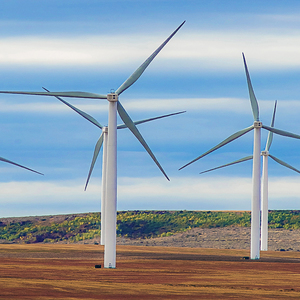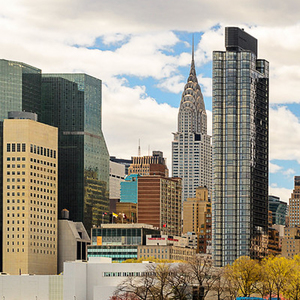
U.S. Representative Alexandria Ocasio-Cortez and Senator Ed Markey are calling for a “Green New Deal” that would involve massive government spending to shift the U.S. economy away from its reliance on carbon.
Their congressional resolution goes into great detail about the harms of climate change and what the U.S. government should do about it. Left unanswered, however, is how America would pay for the proposed deal.
Some commentators have been calling a Green New Deal unaffordable, with some estimates putting the bill for complete decarbonization at as high as $12.3 trillion.
As the author of the United Nations Environment Program’s Global Green New Deal — a plan to lift the world economy out of the 2008-2009 Great Recession — I disagree. I believe there are two straightforward ways to cover the cost and help accelerate the green revolution, while lowering the overall price tag.
What a green new deal may cost
Before we talk about how to pay for it, first we need a rough idea of how much it might actually cost.
For starters, it’s important to be realistic. Rather than putting a price tag on going 100% renewable — which would take decades — I believe we should figure out how much to spend over the next five years to build a greener economy.
Ambitious efforts to foster green energy during the Great Recession are a good place to start.
In total, the world’s largest 20 economies and a few others spent $3.3 trillion to stimulate economic growth. Of that, more than $520 billion was devoted to “green investments,” such as pollution cleanup, recycling, and low-carbon energy.
The U.S. share of that was about $120 billion, or about 1% of its gross domestic product. Around half of this went toward energy conservation and other short-term energy efficiency investments to quickly shore up the then-nascent recovery and generate employment.
The stimulus may have spurred some growth in renewable energy, but didn’t do much on its own to reduce carbon emissions permanently.
Another country that made fairly big green investments during the Great Recession was South Korea, which promoted “low carbon, green growth” as its new long-term development vision. It allocated $60 billion, or 5% of its 2007 GDP, to a five-year plan.
But in the end, South Korea may have spent only $26 billion on low-carbon energy and failed to adopt pricing reforms and other incentives to foster renewables, such as phasing out fossil fuel subsidies, pricing carbon, and improving regulatory frameworks. The result was only a modest improvement in energy efficiency, and carbon emissions have continued to rise.
In other words, the price tag of a Green New Deal that would make a difference would have to be much higher than what governments like the U.S. and South Korea actually spent during the Great Recession. The original South Korea five-year plan, however, to spend 5% of GDP to me seems about right, as the best guess of the public investment needed to decarbonize a major economy through a green growth strategy.
So if we use South Korea as a starting point, that means the U.S. would need to spend around $970 billion over the next five years, or $194 billion annually.
How to pay for the Green New Deal
As for paying for it, the first thing to bear in mind is that in my view a Green New Deal should be covered by current rather than future revenue.
A common way for Congress to pay for the cost of a new program or stimulus is by deficit spending. So the U.S. borrows the money from investors and then eventually has to pay it back through taxes down the road.
With the federal deficit projected to reach $1 trillion in 2019, increasing it by several hundred billion more — even if for a good cause — is not a great idea. Ballooning deficits add to the national debt, which is already $21 trillion and counting.
Saddling future generations of Americans with unsustainable levels of national debt is just as dangerous as burdening them with an economy that is environmentally unsustainable. Deficit spending is warranted to boost overall demand for goods and services, and when unemployment rises, consumers do not spend and private investment drops. When that is not the case, I believe efforts to grow green sectors should pay for themselves.
So the U.S. would have to find new revenue sources to finance additional government support for clean energy research and development, greening infrastructure, smart transmission grids, public transport, and other programs under any Green New Deal. Two of the main ways to do that would be by raising new revenues or finding savings elsewhere in the budget.
On the revenue side, I believe passing a carbon tax is one of the best ways to go. A $20 tax per metric ton of carbon that climbs over time at a pace slightly higher than inflation would raise around $96 billion in revenue each year — covering just under half the estimated cost. At the same time, it would reduce carbon emissions by 11.1 billion metric tons through 2030.
In other words, not only does it help raise money to pay for a transition to a green economy, a carbon tax also helps spur that very change.
In terms of savings, the removal of fossil fuel subsidies is a particularly appropriate target. Consumer subsidies for fossil fuels and producer subsidies for coal cost U.S. taxpayers nearly $9 billion a year. These subsidies could be shifted instead to cover some expenditures under a Green New Deal.
And again, doing this would accelerate the transition to cleaner energy.
So where might the other $89 billion come from?
One option is to simply impose a higher carbon tax. A $20 tax would put the U.S. roughly in the middle among countries that currently impose carbon taxes. But doubling it to $40 per ton would raise an additional $76 billion annually, or $172 billion in total, as well as reduce 17.5 billion metric tons of carbon by 2030.
Another idea is to raise taxes on the highest-earning Americans. For example, imposing a 70% tax on earnings of $10 million or more would bring in an addtional $72 billion a year.
Cost savings
But it’s also possible that the cost of decarbonizing the economy may fall over time.
For example, the drop in emissions accompanying the carbon tax should lower the price tag in a way that’s hard to estimate today. The right policies and reforms would also help lower the costs.
In a sort of “chicken and egg” effect, as economists Ken Gillingham and James Stock have shown, green innovations spur demand, which leads to more innovation, all of which ultimately reduce costs. A good illustration is purchases of electric vehicles, which will stimulate demand for charging stations. Once installed, the stations will reduce the costs of running electric vehicles and further boost demand.
The Green New Deal as proposed by Ocasio-Cortez and Markey would be expensive. But what policies are adopted and how we choose to pay for it could ultimately determine the plan’s success and whether we can afford it.
Edward Barbier is a professor of economics at Colorado State University. This post originally appeared at The Conversation and is republished here under a Creative Commons license.
Weekly Newsletter
Get building science and energy efficiency advice, plus special offers, in your inbox.















12 Comments
This deal, in its whole. Is NUTS.
BUT, MANY GOOD points and ideas in it!! I usually lean conservative, being honest. When they start talking about cow exhaust i wish they would talk about FACTORY FARMING where the problem lies.
This is completely misleading. The author states the US spent ABOUT $120 billion or 1% of GDP and compares that to South Korea spending target of 5% of GDP over a 5 year period.....
all well and good except.......the $120 billion was purportedly spent over a 2 year period meaning the US spent .5% of its GDP per year which over a 5 year period would be 2.5% of GDP.
Of course it plays out much better to say that South Korea committed 5 times as much as the US rather than saying twice as much.
The economics are of course important but the problem is that the plans for the New Green Deal are functionally impossible given the pure physics of what is proposed. For now and into the immediate future (call it the next 10 years) available technology cannot provide the electric power needed to run the country. This includes all accepted methods of "green" power production and storage.
There is a solution. If you add nuclear power to the formula, you can successfully reduce our carbon production and meet the power needs of the country. France is a great example of what is possible.
You wrote, "There is a solution... nuclear power..."
The mean time of construction for a nuclear power plant is 7.5 years, but construction can take 10 or more years. [Source: "How long does it take to build a nuclear power plant?"]
Wind turbines, photovoltaic arrays, and battery storage units can be built far faster -- often in less than two years.
France is actually a TERRIBLE example of what's possible with nuclear power, which is why they are turning strongly toward renewables. France has to throttle back the nuclear fleet during heat waves and high air conditioning loads due to cooling water issues. When a fault with one component common to most of their reactors was discovered they had to run off imported German lignite-fired power for more than a month in recent years. Large centralized power plants are the wave of the past, not the future.
The reason France doesn't have some of the highest electricity rates in Europe is because they financed the construction of nuclear fleet on the backs of the French TAX payers rather than electrical RATE payers. That model won't fly in the US.
The notion that available renewable technology "...cannot provide the electric power needed to run the country..." is a fast fading utility industry cultural bias, not reality. In sunnier parts of the country PV is the cheapest form of new generation, highly scalable to location and load, and highly reliable. In 10 years it'll be the cheapest form of new generation anywhere in the US. In windier parts of the US wind is currently the cheapest form of new generation and continuing to fall in cost year on year.
If there is going to be a future for NEW nuclear power it has to be in smaller easier to site and build units that have more flexible operational characteristics like molten salt reactors, but they're at least 5 years, and possibly more than 10 years from commercialization. At that point they will be competing against even cheaper PV & wind & battery. There is at least one small modular reactor design licensed in the US, but it's currently (perhaps optimistically) slated to go online in 2025. In PV and wind power terms five years is a whole product development/improvement cycle (or two), with double-digit percentage drops in lifecycle cost with every doubling of manufacturing volumes.
Even offshore wind at recent bid prices in New England is far cheaper than new nuclear power, and far quicker to implement. When the Pilgrim nuke in Massachusetts goes offline in June of this year it's contribution to the ISO-NE grid will be replaced in less than 2 years by offshore wind project slated to begin construction later this year, at a net cost savings to the ratepayers.
Transmission lines reduce the bulk storage requirements of the grid. Inflexible large generators like the existing fleet of US nukes increase the bulk storage requirements, and that is not a new phenomenon- a pumped hydro plant was an absolutely necessary co-construction addition to California grid to be able to build & rung the Diablo Canyon nuclear plant, which would not have had sufficient load to keep running overnight, and an insufficient ramp rate to track the bulk load of the following day.
There is a case to be made in particular cases for keeping some of the existing nuclear plants going as more renewables get built, but the case for even finishing current projects (like Vogtle or the recently canceled SCANA reactors) is dubious at best (criminally negligent on the part of local regulators & utility investors at worst.)
Alberta Canada. A case study on the problem of carbon taxes
https://www.fraserinstitute.org/studies/carbon-pricing-in-alberta
Alberta makes a lot of assumptions about the possible effects of carbon taxes, when they could just look next door at British Columbia, which has had them for a decade while the economy boomed.
Alberta's economy is based on expensive resource extraction that no longer makes financial sense. They can dress it up in any way they want, but the boom years there are over, and rather than spend time looking for something to blame, or pretending that somehow they can magically return to the 1970s, they need to re-invent their economy to reflect the global reality everyone faces.
The Fraser Institute is a right-wing "think tank" which resists anything progressive, including energy efficiency, green energy and improvements to building codes, and opposes all taxes merely on principal.
I have lived in Alberta for 35 years, and in British Columbia before that. The carbon tax in Alberta worked well, and resulted in Alberta reducing GHGs by several million tons. In B.C. the carbon tax has been around for 10 years, and is very well liked by the vast majority of the population. It has resulted in a 17% reduction in total GHG emissions while their economy grew by 20%.
This forum should be about better building science, not a platform for vested interest groups.
So are you saying that the conclusion of the study is incorrect? Namely that on the provisional level reductions are largely symbolic because people move to jurisdictions with lower tax due to the fact that having higher taxes than what is federally mandated exacts a higher economic cost.
It makes no sense to trod out "GHC reductions of several million tons" when the GHG producing manufacturing is off shored to some other country. It's akin having people who work for Apple talk about how clean the air is in Cupertino when their products are manufactured in one of the most emissions intensive locations of the world.
There's no free lunch.
So tax the poor working stiff, is your solution. LOL
Who do you think is going to pay the carbon tax... Its the poor and middle class who can't afford PV or EV's.
Even if you believe that the reduction in ghg can effect the climate, spending enormous amounts of other peoples $$, in the US or EU isn't going to make a dent in the overall world totals.
GHG emissions in the US are flat to falling, same in the EU, while China's are higher than the US+EU combined
All the carbon tax will do is to increase the cost of energy, and those tax revenues will likely be blown on government projects that accomplish nothing. I’m totally against the idea of “carbon taxes” primarily for this reason.
There is not currently a way to go to “all renewables”. I’m not so sure there ever will be. The simple fact is that the energy density is just not there for solar and wind power. Large numbers of relatively small generators also tend to operate at lower overall efficiencies than a large, central plant which is the main reason we have a power grid the way we do today. This is about physics, not government and not profits.
Dana, additional transmission infrastructure will help to allow for variable generators like wind farms to “average out” their variability over larger geographic areas, but that comes at a cost. The cost is in reliability and system losses. Very large power grids do not operate the same was as small systems in buildings. Very long lines are subject to inductive effects than can result in voltage instability (output voltage can be higher than input voltage, as one example). There is a lot of info out there on the 138kv transmission line that runs from the Florida mainland out to key west. You can read about all the unique issues that line has.
A solution to some of these problems is HVDC (high voltage DC), which is more controllable and is not subject to the inductive issues of extremely long AC lines. The downside is that the converter stations are complex, so these lines are only practical on long point-to-point routes — no tapping off distributed generation like wind farms is easily possible.
Distributed sources like wind farms are not actually as distributed as people like to think. Wind farms typically have “collector grids” that connect only the wind turbines together, with a single substation connecting the large wind farm back into the bulk power grid. Solar is the same. It is not as easy as just hanging little generators off of the existing power lines everywhere.
Regarding the proposed “green” deals, so far they are almost entirely political. There is nothing green about them.
Bill
I have a friend who says Thorium is the answer.
https://www.forbes.com/sites/energysource/2012/02/16/the-thing-about-thorium-why-the-better-nuclear-fuel-may-not-get-a-chance/#c97b4e41d803
he even thinks that ir may be possible to have miniature personal reactors
Log in or create an account to post a comment.
Sign up Log in